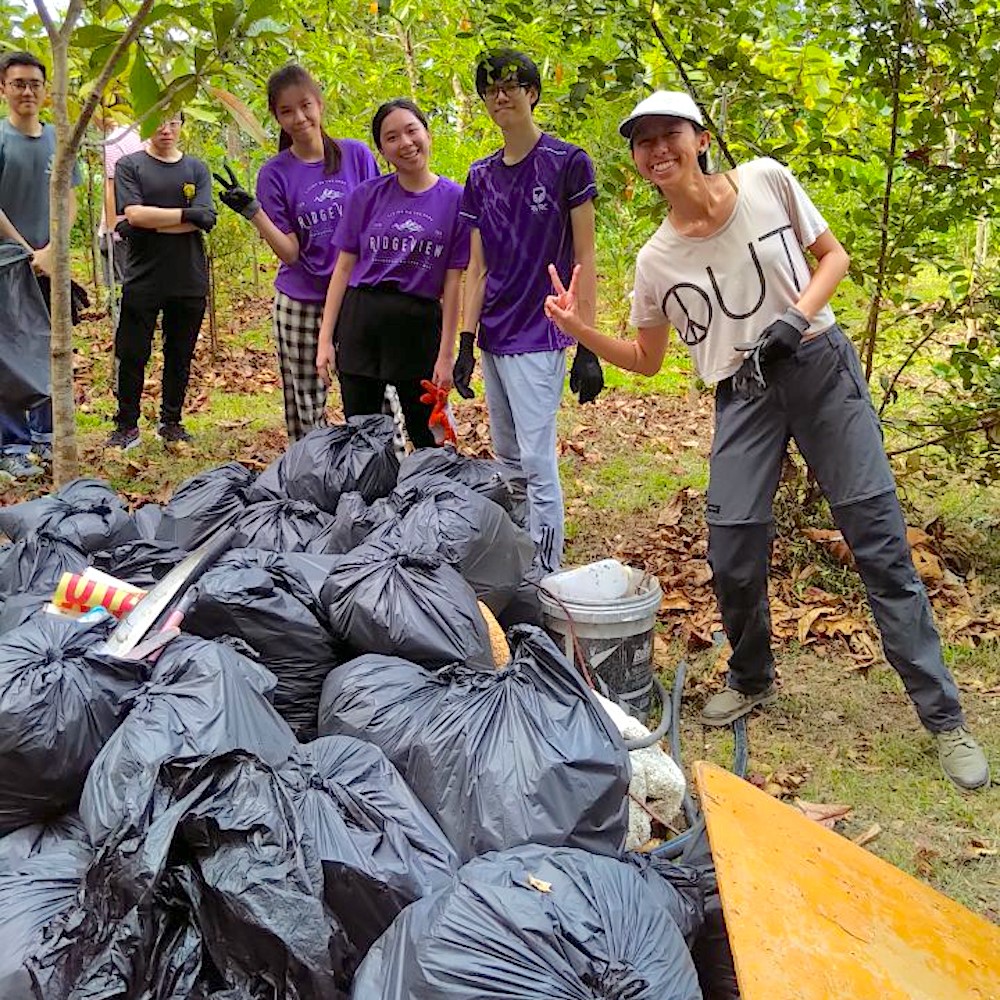
As part of the RVRC Coastal and Mangrove Cleanup outdoor learning programme, the Green Rangers interest group organised a mangrove clean-up in conjunction with Little Green Men [add hyperlink to https://littlegreenmensg.wordpress.com/ ] on 18th March in Kranji Coastal Nature Park, the extension of Sungei Buloh Wetland Reserve. 20 participants from RVRC, SUSS, and the general public collected a whopping 96kg of marine litter in one hour. Using the low tide, we were able to enter the fenced off site after NParks had granted us permission to collect marine debris that had accumulated at the high tide mark along the granite enforced coastal wall. This litter, ranging from styrofoam to single use plastic, threatens the growth of mangrove saplings in the natural mangrove rewilding site. RVRC students worked hard alongside fellow participants to collect as much rubbish as possible, and managed to fill 52 bags. Well done for doing your part to make Singapore waters cleaner and safer for all living beings!
The outdoor learning experience sparked a lot of interest about Singapore’s coastal environment and deep reflections from participants:
Eliza Lim Siew Ping
Yesterday, I had the opportunity to participate in a mangrove clean-up activity at Sungei Buloh Wetland Reserve, and it was an eye-opening experience for me. One of the things that fascinated me the most was discovering that the patch of mangrove we were cleaning up was actually supposed to be underwater. However, because of the low tide, we were able to access it and remove the accumulated trash. This realisation gave me an idea of how much waste and pollution must be lurking underwater and how important it is to take action to prevent it from happening. During the clean-up, I learned about the importance of mangroves and how these places play a vital role in our ecosystem. It was fascinating to see how a single change in an environment can affect a vast range of species. Moreover, I got to see the direct impact of pollution and waste on mangroves, which is a real issue that requires our immediate attention. The most memorable aspect of the clean-up for me was the amount of trash we collected. It was astounding to see how much single-use plastics and plastic food containers were present in the area. We ended up collecting around 97kg worth of trash. While we were proud of our contribution, this revelation was quite disappointing, as it showed that people's awareness of waste packaging is still quite low, and this behaviour is reflected in our society's habits, practices, and lifestyle. Overall, the experience was both fulfilling and educational. It made me realise how essential it is to take responsibility for our waste and the impact it has on our environment. Additionally, the clean-up provided me with a chance to take a break from my intensive studies and contribute to my community and the environment. I am grateful that I participated in the activity and left feeling motivated to continue spreading awareness and making positive changes in my daily life to reduce my waste footprint
Gracia Goh Pei Xuan
It was my first time participating in a mangrove clean up and clearing the trash was a visceral experience that really forced me to confront our problem of single use plastic. I also learnt about the detrimental effects of pollution to mangroves specifically, as they are important habitats to local species like horseshoe crabs. The most memorable part of the clean-up was looking at the impact that we had made. After the clean-up, the site appeared to be much cleaner and natural. I also realised that the large amounts of tiny little plastic parts and styrofoam, some of them stuck to the mangroves, meant that clearing every piece up would be nearly impossible. But I felt happy that we had done our best, and that the horseshoe crabs could have a better home.
Chan Kwai Wei
Having been here for the coastal cleanup last year as well, it was disheartening to see that there was more trash that we picked up compared to before. There was also a really foul smell of dead fish mixed with the trash, which might have come from places where the fish were diseased and discarded into the sea. Doing all these cleanups gives me a vivid reality outlook on not just what we are doing to our environment, but also what we can do to mitigate or prevent such pollution events from happening. Despite seeing all the various types of garbage washed unto the shore, mostly consisting of plastic bottles and styrofoam pieces, I always find the scenery, atmosphere and refreshing gusts of wind mesmerising. We also managed to pick up about 96kg of waste in just 1 hour, and it was memorable to see how much everyone's effort can make!

